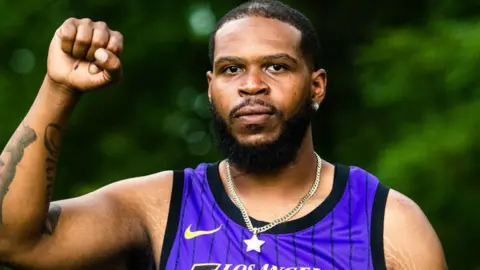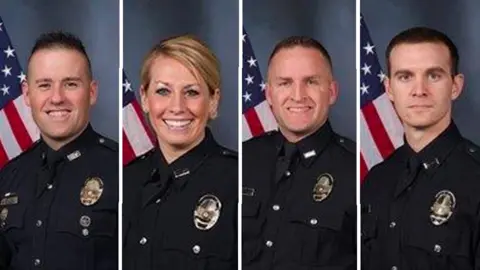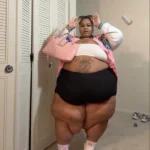
Introduction: A Fatal Raid That Sparked Outrage
On March 13, 2020, Breonna Taylor, a 26-year-old emergency medical worker, was shot and killed in her apartment in Louisville, Kentucky, during a botched raid conducted by the Louisville Metro Police Department (LMPD).
The officers—Jonathan Mattingly, Brett Hankison, and Myles Cosgrove—executed a no-knock warrant, forcing entry into her home as part of a narcotics investigation tied to Taylor’s ex-boyfriend, Jamarcus Glover.
Taylor’s boyfriend, Kenneth Walker, believing their home was being broken into, fired a single shot, which struck Mattingly in the leg. The police responded with 32 rounds of gunfire, striking Taylor six times and killing her in her hallway.
Despite the public outcry, no officers were immediately charged in connection with Taylor’s death. It would take years of legal battles, federal investigations, and relentless activism before any real accountability was seen.

The Night of March 13, 2020: How the Raid Unfolded
The Warrant That Started It All
The LMPD had obtained a no-knock warrant for Taylor’s apartment as part of an ongoing drug investigation into Jamarcus Glover, Taylor’s ex-boyfriend.
Authorities suspected that Glover was using Taylor’s residence to receive drug packages, though there was no confirmed evidence to support this claim.
The warrant application was riddled with false information. It stated that postal inspectors had confirmed suspicious packages were being sent to Taylor’s apartment—a claim that was later proven false.
The actual postal inspectors denied providing such information to the LMPD, raising serious questions about the legitimacy of the warrant.
The warrant was authorized by Judge Mary Shaw, who later faced public scrutiny for approving five separate warrants in under 12 minutes—one of which targeted Taylor’s home.
Officers Arrive at Taylor’s Apartment
Just after midnight on March 13, seven plainclothes officers from LMPD arrived at Taylor’s apartment on Springfield Drive.
The officers claimed they announced themselves multiple times, but Walker and at least 11 of Taylor’s neighbors stated they never heard police announce their presence.
Walker, hearing loud banging, believed their home was being broken into by criminals. In response, he grabbed his licensed firearm and fired a single warning shot, which struck Sergeant Mattingly in the leg.
What happened next was a chaotic, uncontrolled burst of gunfire.
32 Bullets Fired: Taylor Is Killed in a Hail of Bullets
- Mattingly fired six shots as he retreated from the doorway.
- Cosgrove fired 16 shots into the apartment in just seconds.
- Hankison, who was positioned outside the apartment, fired 10 rounds blindly through a covered patio door and a bedroom window.
In total, 32 bullets were fired into Taylor’s apartment.
Taylor, who had been standing in the hallway, was struck six times. The fatal shot was later determined to have been fired by Cosgrove.
Walker, meanwhile, was not hit at all.
Despite the massive amount of gunfire, police never found drugs, money, or any illegal substances in Taylor’s home.
The Aftermath: Police Failures & Misinformation
- No Immediate Medical Aid: After the shooting, Taylor lay dying on the floor, but no officers provided medical assistance. It was later revealed that it took over 20 minutes for paramedics to reach her.
- False Police Report: The initial police incident report falsely stated that Taylor had no injuries, despite her having been shot six times.
- Walker’s Arrest: Police arrested Walker and charged him with attempted murder of a police officer—a charge that was later dropped after public outcry.
Legal Fallout: A Slow Path to Justice
Initial Investigations and the City’s Response (2020-2021)
- April 2020: The FBI opened an investigation into Taylor’s killing.
- May 2020: Nationwide protests erupted, demanding justice.
- June 2020: LMPD fired Brett Hankison for recklessly firing into the apartment.
- September 2020: The City of Louisville paid Taylor’s family $12 million in a wrongful death settlement.
- September 2020: A grand jury declined to indict Mattingly or Cosgrove, ruling their use of force was justified since Walker fired first.
- September 2020: Hankison was indicted on three counts of wanton endangerment—but only for endangering Taylor’s neighbors, not for her death.
- October 2020: Jurors accused Kentucky Attorney General Daniel Cameron of misrepresenting evidence and steering them away from homicide charges.
At this point, only Hankison faced any charges, and none were directly related to Taylor’s death—fueling outrage, protests, and continued demands for police accountability.
Federal Charges and Mistrials (2022-2024)
- August 2022: The U.S. Department of Justice indicted four officers—Brett Hankison, Kelly Goodlett, Joshua Jaynes, and Kyle Meany—on civil rights violations and obstruction of justice.
- August 2022: Goodlett pleaded guilty to falsifying the search warrant, admitting the affidavit contained false information.
- November 2023: Hankison’s first federal trial ended in a mistrial after jurors failed to reach a verdict.
- August 2024: A federal judge dismissed key civil rights charges against Jaynes and Meany, ruling that Walker’s gunfire—not the warrant—was the legal cause of Taylor’s death.
- November 2024: Hankison was found guilty of violating Taylor’s civil rights by firing recklessly into her home.

A Nationwide Movement: The Impact of Taylor’s Killing
Taylor’s death became a rallying cry for police reform and racial justice, leading to widespread protests and policy changes.
Legislative Reforms
- June 2020: Louisville banned no-knock warrants, passing “Breonna’s Law”.
- April 2021: Kentucky restricted but did not fully ban no-knock warrants.
- Nationally: Calls for federal police reform intensified, but Congress failed to pass national legislation banning no-knock raids.
Cultural Impact & Public Reactions
- #SayHerName became a national movement, highlighting police violence against Black women.
- Athletes, celebrities, and activists continued demanding justice, including LeBron James, Oprah Winfrey, and Regina King.
- The September 2020 cover of O Magazine featured Taylor—the first time in its history that Oprah Winfrey wasn’t on the cover.
- Protests erupted across the country, especially after no officers were indicted for Taylor’s killing.

Where Does the Case Stand Today?
- Hankison awaits sentencing in March 2025 for federal civil rights violations.
- Goodlett, Meany, and Jaynes face additional legal proceedings for falsifying the warrant.
- Despite reforms, no federal law has banned no-knock warrants nationwide.
Taylor’s case remains one of the most significant examples of police misconduct in recent years. While some officers were held accountable, many feel justice was incomplete, as the officers directly responsible for her death never faced homicide charges.
The question remains: Has the outrage over Taylor’s death led to real change, or will this be just another cycle of forgotten promises?




Featured image: A memorial to Breonna Taylor at Jefferson Square Park in Louisville, Ky., in 2020. Photo: The New York Times





